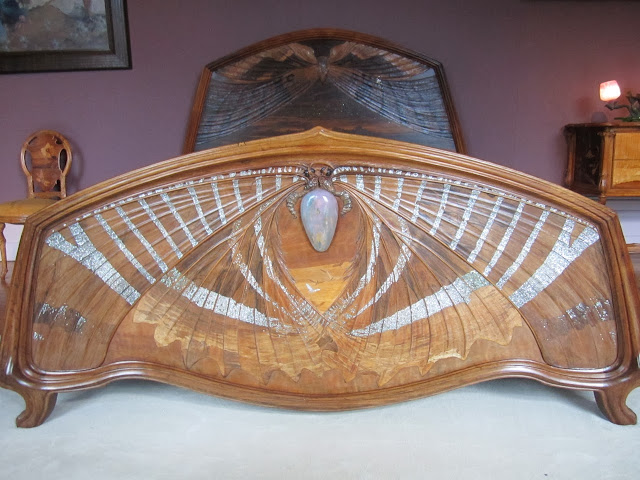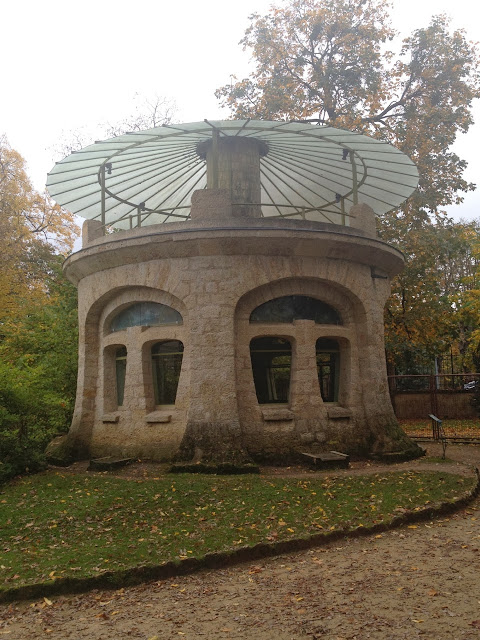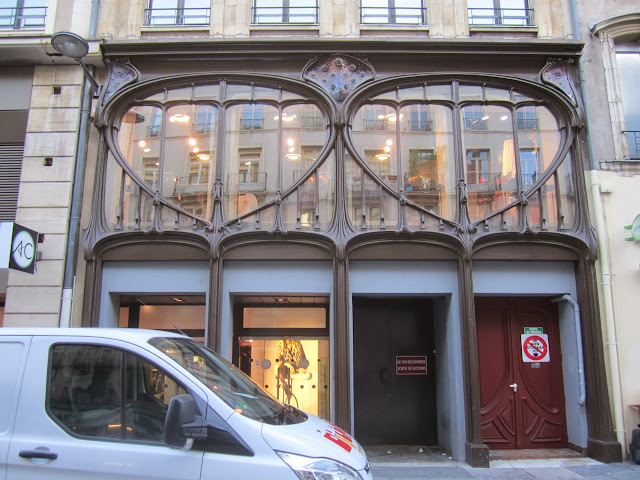28 October 2013
Nancy Part III
l’Art Nouveau architecture of Nancy, France
Anybody who has suffered through my last three posts knows that there is one thing for which Nancy is very famous and is, above and beyond, the real reason that I chose to go there in the first place. That reason is the Art Nouveau. As I said a few days ago in my post, the Art Nouveau is a style that arose at the end of the nineteenth century as a sort of retaliation against the perceived industrialization and modernization of art and architecture. (Think Eiffel Tower.)
Not only was it a style of art and architecture, it was really an entire mentality that lasted until the First World War when Art Deco really started taking over. Described in 1894 by Pan magazine as having the “sudden violent curves generated by the cracking of a whip,” Art Nouveau is really hard to describe. It undulated, it turns, it twists, it flows, it drips, it makes forms that hardly seem possible by human hands - it does it all. It seems to grow out of the ground, often using plant forms, and then it morphs into a building, or at least a piece thereof. It is absolutely amazing and, for me, a good Art Nouveau building is awe-inspiring. I try to understand how the architect even drew the plans for what I see and it seems to involve a dimension of space that I didn’t even know existed! I see it in front of me but I don’t have the slightest idea how it was conceived because the shapes just seem so bizarre. And I think that’s what I love about it. It confuses me a lot of the time. It really forces me to slow down and think about each piece and how it interacts with another. What is that piece? What is it like that? It is not a Greek temple where you know (basically) what to expect. Art Nouveau is always different. Parisian Art Nouveau differs by region of the city, with Hector Guimard holding down the 16th but other architects putting their mark on other areas. Parisian Art Nouveau is totally different from Nancy, and both are 100% different from what is seen in Belgium or other European countries.
For my posts on the Art Nouveau of Paris see my posts of October 8, 2013 and - November 28, 2011,
For more about Brussels, Belgium see “Toussaint Traveling Trilogy, Part I” November 1, 2011
For more about the Art Nouveau of Antwerpen, Belgium - which is super - see my post from November 15, 2011
Anyway, for me this attenuated and spindly style is feminine and, dare I say it, sexy. With all of its curves and lines it’s seductive and sensual, if a building made of carved stone and twisted metal decoration can be called sensual and seductive. Luckily I think it can. I could spend as much, if not more, time looking at a really spectacular Art Nouveau building as I could looking at the most beautiful female in the world. And better yet, the building won’t talk back.
Despite my interest in the Art Nouveau style of architecture, and particularly its furniture, I have no desire to ever live in an Art Nouveau house. I think it would be overwhelming. Your eyes would never stop moving and I know I’d become tired from tracing the curves and lines all around the room. I would certainly enjoy having a few choice pieces of Art Nouveau furniture scattered in my life, but I don’t need much more than that.
Interestingly, the Art Nouveau never really took off in America. Some architects like Louis Sullivan used Art Nouveau details, and Louis Comfort Tiffany made his stained glass windows in a very Art Nouveau manner, but buildings and furniture like what is seen in Europe just never really took off in America. Instead Americans of the time were focussed on the nascent Arts and Crafts movement (which also rejected modern technology in favor of the “handmade, handcrafted” look), the Shingle Style, and any number of other styles, many of which shared certain characteristics.
One of the most important cultural institutions of Nancy, France is the Musée de l’École de Nancy, which is museum dedicated to the school that imparted the ideals of the Art Nouveau style unto its students. It is housed in the former house of Jean-Baptise Eugène Corbin, one of the leading patrons of the École de Nancy. He donated his collection of École de Nancy artwork to the City of Nancy in 1935 and was transferred in 1964 to his former residence. It is truly a sight to behold. The house hardly resembles the house that Corbin would have known but it now holds a collection that is truly unparalleled.
First door you see as you enter the Museum grounds - which is really just somebody's office today, unfortunately
Museum from the street
The foyer to the museum
I love this settee soooo much and which it was placed in an area that allowed better photographs.
It was designed by Eugène Vallin in 1902 for a house in Nancy
from the other side showing the cabinet
detail
I love this photo
I wish the picture that gave the information on this bed wasn't so blurry...
The bedroom set of Louis Majorelle
This is the dining room of Charles Masson by Eugène Vallin and Victor Prouvé, 1903-1906
Nothing is known about the giant ceramic mural other than it was given to the museum by the State, but the stained glass window is by Henri Bergé.
Jacques Gruber, 1909
Just a very small portion of a stained glass sunroom by Jacques Gruber
Out in the garden is this great 1904 folly structure that was built as an aquarium to "contemplate underwater life"
Scattered throughout Nancy are dozens of other buildings showing signs of the Art Nouveau Movement and I visited over sixty of them. I found a great little pamphlet listing 67 sights throughout the city and I checked off all but 8 of them. I did, however, find a number of buildings that were not listed on the map, so I feel quite accomplished with the ground I covered and with number of amazing buildings I saw.
The Weissenburger Building, 1903-1904, Lucien Weissenburger, Iron by Majorelle, Glass by Gruber
Maison Huot, 1903, Émile André
detail of the super cool letter box
The Margo Building, Eugène Vallin and Paul Charbonnier, 1906
Part of a number of buildings by César palin between 1900-1910
many of which had these wonderful ceramic name plates
This may have been the most amazing house I saw because it looked so modern. It's the house of Louis Majorelle and was designed by Henri Sauvage and was built from 1901-1902. Stained glass by Gruber, Iron by Majorelle, Glazed stoneware by Alexandre Bigot.
These are two buildings, done between 1909-1904 by Émile André
The Biet house, by Georges Biet and Eugène Vallin. The enclosed sunporch was an addition in 1927 following reconstruction necessitated by World War I.

When I was over in the neighborhood of the museum I noticed that there was a cemetery in the area of a number of the Art Nouveau buildings, and being one who wants to really take in the full ambiance of an area, I decided that I should visit the cemetery. Who knows, maybe there would be something there that interested me. Well I walked in to find a giant map with some local celebrities listed and who should be listed but some of the members of the École de Nancy. Well I decided that I really ought to visit the former faculty members and see if they did anything spectacular with their grave sites. (In France it’s very common to build little chapels on grave sites or make very impressive tombs - sort of like Père Lachaise in Paris.) For the most part the tombstones were a bit underwhelming, but there were a few that were notable. Interestingly, the tombstones of two of the most important Art Nouveau artists, Émile Gallé and Louis Majorelle were anything BUT Art Nouveau.

Louis Majorelle's tomb - not Art Nouveau
the Gallé family headstone. Not Art Nouveau
But this one is!
The Corbin family was the family who amassed the collection that is now the Musée de l'École de Nancy
My map also took me to Le Parc de Saurupt, a failed development from 1901 using the architects Henry Gutton and Émile André. Of the 100 buildings planned for the site by the architects, only 7 were constructed and the project was later reformed from individual houses to semi-detached ones. All of them are really lovely, however.
The gatekeeper's house, 1902, Émile André
Villa Frühinsholz, Léon Cayotte, 1908-1910, Stained glass by Gruber
Villa Les Glycines, 1902-1904, Émile André
Some of the houses had great gate posts
Villa Marguerite, 1903-1905, Joseph Hornecker
As the project became a series of semi-detached houses
This is great, with the scooters and old sewing machine by the door.
One of my favorite things was the use of Art Nouveau in commercial and public buildings in Nancy. It’s so strange to see things like a Bank with a super feminine facade or interior. It’s beautiful, for sure, and it certainly changes the way a street feels when you go from boring, vernacular, stone storefronts to this beautiful facade that actually stands out and makes you look for a few minutes. Likewise when you enter a building and the interior decoration just knocks your socks off. In the case of the Excelsior Brasserie, I was actually speechless for a solid 10 seconds, and that’s saying something.
Bank, 1910, Émile André and Paul Charbonnier, iron by Majorelle
The Goudchaux Shop, 1901, Eugène Vallin
I love how even the new sign matches the style of the Art Nouveau in terms of lettering
The Gaudin House, 1899, Georges Biet, stained glass by Gruber
Royer Printing Works, 1899-1900, Lucien Weissenburger, arch't., Ernest Bussière, sculp't.
Look at how the peacock design is sort of iridescent.
Crédit Lyonnais Bank, 1901, Stained glass by Jacques Gruber
The Excelsior, of course. (All the architectural info is in the last blog post)
While I was sitting looking at some of these buildings, I couldn’t help but try to wonder what it was about these structures and this style that intrigues me so. From the exterior, looking at me and looking at these buildings, we couldn’t be much more dissimilar. I’m a fairly conservative, straight-laced person. I like traditional things and I’m not one who is usually into super flashy out of the box ideas. But then I started looking at the curves and forms, and then at the tactile nature of the surfaces and realized how much I just wanted to touch them (in a “good touch” way). It reminded me of a few buildings back home with some very wonderful shapes, curves, and details. (N.B. if only more females in coastal Maine had such wonderful shapes, curves, and details...)
A now destroyed Northeast Harbor summer cottage, 1890, Fred Savage
St. Sylvia's Catholic Church, Bar Harbor, Maine, W.R. Emerson, archt., 1881-1882
photo courtesy of the Library of Congress Digital Collection
The author (and his appendix-less friend) is (are both) indebted to the infamous
Downeast Dilettante for introducing him (them) to this wonderful structure and its great lines on very short notice on an afternoon trip in coastal Maine this past summer. If you want to read more about this building, click
HERE
Then I realized that one of the reasons that I love the style of my home island, the Shingle Style, is because you frequently find these amazing curves and incredibly beautiful forms - often times very beautiful using almost surprising shapes and forms. While the Shingle Style definitely doesn’t have the same historical background as the Art Nouveau, it has the same appeal to me. It’s so tactile. There are so many textures. There are so many curves and shapes. It sort of grows out of the ground, but in a different way from the tall stone buildings of the Art Nouveau.
The Bergeret House, 1903-1904, Louis Weissenburger, Ironwork by Majorelle, stained glass by Gruber
Seaward, 1891, Wells Bosworth, Northeast Harbor, Maine
Even though I could probably list more dissimilarities than similarities, I think it the subtle similarities sort of remind me, at least in some sort of subconscious way, of what I love. Of the Shingle Style. Who ever would have thought that something so uniquely European as the Art Nouveau would make me think of something so uniquely American as the Shingle Style. In a way it’s sort of reassuring. It’s definitely different, and I understand that, but it makes me think about the architecture that made me fall in love with architecture, and that makes me happy.
Shameless selfie of the author standing in the Art Nouveau/Art Deco transition part (basement of the entry hall) of the Excelsior.




























































